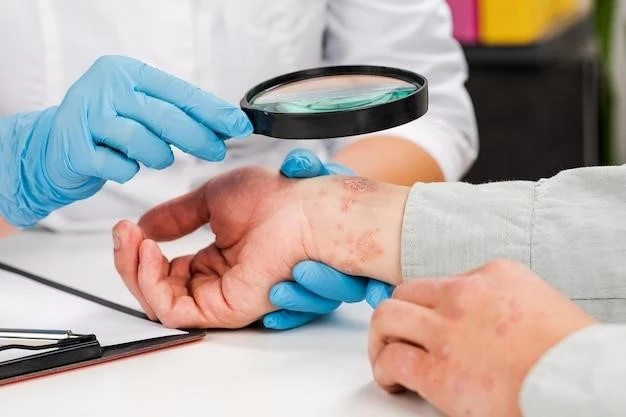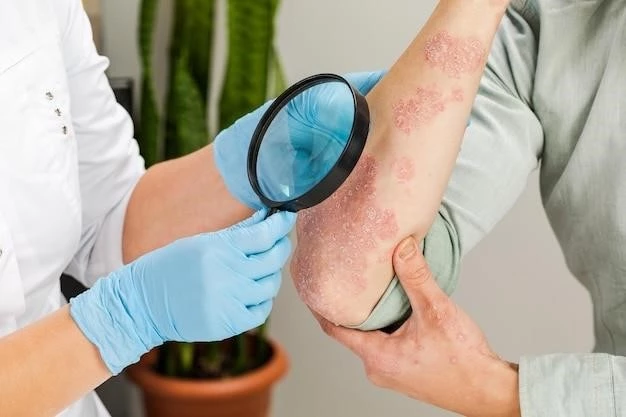Article Plan⁚ Disease ⎼ Parapsoriasis
In the realm of dermatological conditions, the term parapsoriasis was initially coined by renowned dermatologist Brocq in 1902․ It encompasses a variety of skin diseases, the most common of which are small-plaque parapsoriasis (SPP) and large-plaque parapsoriasis (LPP)․ These conditions are often characterized by scaly patches resembling psoriasis, but distinct in their clinical presentation and potential risks․
Introduction to Parapsoriasis
Parapsoriasis is a term used to describe a group of skin diseases characterized by scaly patches that resemble psoriasis but have distinct features․ Originally coined by Brocq in 1902, parapsoriasis encompasses various forms, with the most common being small-plaque and large-plaque parapsoriasis․ These conditions can present with red or pink scaly patches on the skin, often affecting older adults․
While small-plaque parapsoriasis is usually benign but chronic in nature, large-plaque parapsoriasis is considered a premalignant dermatosis, potentially progressing to mycosis fungoides, a type of cutaneous T-cell lymphoma․ Differentiating between types of parapsoriasis is crucial due to varied clinical manifestations and potential risks of progression․
The cause of parapsoriasis is largely unknown, and diagnosing this condition may involve a physical examination, skin biopsy, and genetic testing to rule out other skin disorders like cutaneous T-cell lymphoma․ Treatment options range from topical corticosteroids for small-plaque parapsoriasis to more intensive therapies for large-plaque parapsoriasis, necessitating follow-up care to monitor progression and possible transformation into malignancy․
Research is ongoing to better understand the underlying causes of parapsoriasis and improve diagnostic and treatment strategies for this group of skin disorders․ Patients with parapsoriasis should seek regular medical evaluation to manage symptoms effectively and address any potential risks associated with this condition․
History and Classification
Parapsoriasis, a term introduced by Brocq in 1902, encompasses a group of skin diseases characterized by scaly patches resembling, but distinct from, psoriasis․ The classification includes small-plaque and large-plaque forms, each with specific clinical features and risks․ Small-plaque parapsoriasis, a benign chronic condition often treated with topical steroids, contrasts with large-plaque parapsoriasis, considered premalignant and potentially progressing to cutaneous T-cell lymphoma․

Over the years, parapsoriasis has been associated with various skin manifestations, leading to its classification into different subtypes․ Understanding the history and classification of parapsoriasis is crucial for accurate diagnosis, treatment selection, and monitoring for potential progression to more serious conditions like cutaneous T-cell lymphoma․
Stay informed about the evolving classification and historical context of parapsoriasis to ensure appropriate management and timely intervention, especially for individuals with large-plaque parapsoriasis who require closer monitoring due to the risk of malignancy;
Clinical Presentation
Parapsoriasis is an umbrella term for a group of skin disorders characterized by red or pink scaly patches that resemble psoriasis but have distinct features․ The two main types are small-plaque parapsoriasis (SPP) and large-plaque parapsoriasis (LPP)․ SPP typically presents as patches less than 2 inches in diameter on the skin, often found on the trunk, while LPP consists of larger patches that can be premalignant and potentially progress to cutaneous T-cell lymphoma․
When diagnosing parapsoriasis, healthcare providers examine the patches on the skin to determine the appropriate course of treatment․ A skin biopsy may be necessary to confirm the diagnosis and rule out other conditions like cutaneous T-cell lymphoma․ Treatment options vary, with SPP often responding well to topical steroids, while LPP may require more intensive therapies like phototherapy․
Monitoring and follow-up care are crucial for individuals with parapsoriasis, especially those with LPP, to track any potential progression to malignancy․ Regular check-ups and skin biopsies help assess the prognosis and minimize risks associated with the condition․ Understanding the clinical presentation of parapsoriasis and seeking medical advice can aid in effective management and potential prevention of complications․
Types of Parapsoriasis
Parapsoriasis encompasses distinct forms, with the most common types being small-plaque and large-plaque parapsoriasis; Small-plaque parapsoriasis typically appears as red or pink scaly patches on the skin, while large-plaque parapsoriasis consists of larger patches that may have a premalignant potential․ Understanding the differences between these types is crucial for accurate diagnosis and appropriate treatment selection․
Small-plaque parapsoriasis is often benign and chronic, presenting as patches less than 2 inches in diameter, primarily located on the trunk․ In contrast, large-plaque parapsoriasis is considered premalignant and may progress to cutaneous T-cell lymphoma, requiring closer monitoring due to the associated risks․ While the exact cause of parapsoriasis remains unclear, recognizing and differentiating between these types is essential for effective management and follow-up care․
Stay informed about the characteristics and distinctions between small-plaque and large-plaque parapsoriasis to facilitate early detection, intervention, and potential prevention of complications associated with these specific subtypes of the condition․
Small-Plaque Parapsoriasis (SPP)
Small-plaque parapsoriasis (SPP) is a type of parapsoriasis characterized by predominantly CD4 T cells and a genotypic pattern similar to chronic dermatitis․ This benign yet chronic condition presents with patches less than 2 inches in diameter٫ often found on the trunk․ The management of SPP typically involves symptom-based approaches٫ with topical treatments like high-potency corticosteroids being effective in many cases․
A novel method reported in 2018٫ hydrogen-water bathing٫ has shown promise in treating SPP by utilizing water with enhanced reactive oxygen scavenging properties․ While SPP generally has a good prognosis and rarely progresses٫ regular follow-up care is recommended to monitor any changes and ensure timely intervention if needed․
Recognizing the clinical manifestations of SPP and understanding available treatment options can aid in effectively managing this subtype of parapsoriasis․ If you suspect you have SPP or experience persistent skin issues, consult a dermatologist for a proper evaluation and guidance on the most suitable treatment plan․
Large-Plaque Parapsoriasis (LPP)
Large-plaque parapsoriasis (LPP) is a chronic skin condition characterized by patches larger than 2 inches in diameter, often found on the trunk or buttocks․ Considered a premalignant dermatosis, LPP has the potential to progress to mycosis fungoides, a type of cutaneous T-cell lymphoma․ Individuals with LPP may exhibit red or pink scaly lesions that differ from those seen in small-plaque parapsoriasis․
It is crucial to seek medical attention if you suspect LPP, as early diagnosis and management are essential to prevent progression to malignancy․ Treatment options for LPP may include high-potency topical corticosteroids and other therapies tailored to the individual’s condition․
Regular follow-up care is recommended for individuals with LPP to monitor the skin’s response to treatment and track any changes that could indicate progression․ Understanding the clinical manifestations of LPP and collaborating with healthcare professionals can help in effectively managing this subtype of parapsoriasis and minimizing associated risks․
Relationship with Psoriasis
Although both parapsoriasis and psoriasis manifest with scaly patches on the skin, they are distinct skin conditions․ Parapsoriasis, characterized by red or pink scaly patches, is not a form of psoriasis but is named for its similar appearance․ Psoriasis and parapsoriasis differ in age prevalence and disease progression․ While parapsoriasis often affects middle-aged adults, psoriasis is more common in younger individuals and children․
Understanding the differences between these conditions is crucial for accurate diagnosis and appropriate treatment selection․ If you experience persistent skin issues resembling psoriasis, consult a dermatologist for a thorough evaluation to determine the specific skin disorder and develop an effective treatment plan tailored to your needs․
Diagnosis of Parapsoriasis
Diagnosing parapsoriasis is essential for appropriate management․ Healthcare providers may conduct a physical exam to assess skin patches, perform a skin biopsy to confirm the diagnosis, and use genetic and molecular testing to rule out cutaneous T-cell lymphoma (CTCL)․ Making a definitive diagnosis involves differentiating parapsoriasis from other skin conditions to determine the most effective treatment plan․
If you suspect you have parapsoriasis or experience persistent skin issues, seek a thorough evaluation from a dermatologist․ The diagnostic process may include a comprehensive examination of skin lesions, potentially followed by additional tests to confirm the presence of parapsoriasis and rule out more serious conditions․ Early and accurate diagnosis is pivotal in providing timely intervention and suitable treatment options tailored to your specific condition․
Stay proactive about your skin health and consult with a healthcare professional if you notice any unusual skin changes or symptoms that resemble those associated with parapsoriasis․ Regular skin screenings and prompt diagnosis are vital for effective management and potential prevention of complications related to this dermatological condition․
Differential Diagnosis
Diagnosing parapsoriasis involves considering other health conditions that share similar symptoms to ensure an accurate evaluation․ Conditions such as psoriasis, mycosis fungoides, and pityriasis lichenoides may resemble parapsoriasis but require distinct diagnostic approaches․ Psoriasis is a common skin disorder characterized by raised, red, scaly patches, while mycosis fungoides is a type of cutaneous T-cell lymphoma that can manifest as skin lesions․ Pityriasis lichenoides, on the other hand, presents as red lesions evolving into papules․
Consulting a healthcare provider for a comprehensive assessment and possibly undergoing skin biopsies can aid in confirming or ruling out parapsoriasis and differentiating it from similar skin conditions like psoriasis and mycosis fungoides․ Seeking expert medical advice ensures an accurate diagnosis and appropriate management tailored to your specific skin disorder․
Be proactive in discussing any concerning skin symptoms with a dermatologist for a thorough evaluation and differential diagnosis to determine the most suitable treatment plan for your skin condition․
Treatment Options
When it comes to treating parapsoriasis, the approach may vary depending on the subtype and severity of the condition․ Small-plaque parapsoriasis (SPP) is usually benign but chronic and can often be managed conservatively based on symptoms․ Topical treatments like high-potency corticosteroids are commonly effective in addressing the patches associated with SPP․
A novel treatment for parapsoriasis reported in 2018 involves hydrogen-water bathing, which utilizes water with enhanced reactive oxygen scavenging properties․ While this modality has shown promise, its efficacy may vary among individuals․
On the other hand, large-plaque parapsoriasis (LPP) is considered a premalignant dermatosis and may require more aggressive treatment strategies․ Topical steroids at high potency are often employed in managing LPP, along with other interventions tailored to the individual’s specific condition․
Regular follow-up care is essential for individuals with parapsoriasis, particularly those with LPP, to monitor the response to treatment and track any potential progression that could indicate a need for further interventions․ Collaboration with healthcare providers is key in determining the most suitable treatment options for managing parapsoriasis effectively․
Management and Follow-Up Care
Effective management of parapsoriasis involves regular follow-up care to monitor the condition and track any potential progression․ For small-plaque parapsoriasis (SPP), a symptom-based approach is often sufficient, with topical treatments like high-potency corticosteroids proving effective in many cases․ Additionally, hydrogen-water bathing has shown promise as a novel treatment modality for SPP․
On the other hand, large-plaque parapsoriasis (LPP), being considered a premalignant dermatosis with a risk of progressing to cutaneous T-cell lymphoma, may require more aggressive treatment strategies․ Topical steroids at high potency are frequently utilized in managing LPP, along with other tailored interventions․
Regular follow-up visits with healthcare providers are crucial for individuals with parapsoriasis, particularly those with LPP, to assess the response to treatment and address any changes that could indicate the need for further interventions․ Monitoring the condition closely and collaborating with medical professionals can help in ensuring optimal management and reducing the risk of progression to more serious complications․
Prognosis and Risks
The prognosis of small-plaque parapsoriasis (SPP) is generally favorable, with the condition being chronic but often benign․ SPP patches are usually asymptomatic and rarely progress to more serious complications․ On the other hand, large-plaque parapsoriasis (LPP) is considered a premalignant dermatosis, carrying a higher risk of progressing to cutaneous T-cell lymphoma (CTCL)․
Individuals with LPP require close monitoring due to the risk of malignancy development․ Regular follow-up visits with healthcare providers are crucial to track any changes in the skin lesions and promptly address any signs of progression․ Skin biopsies may be recommended to assess the risk of progression to CTCL and guide further management․
Stay vigilant about any new or changing skin lesions if you have parapsoriasis, especially LPP․ Seeking timely medical attention and adhering to recommended follow-up care can help in managing the condition effectively and minimizing the risks associated with its potential progression․
Research and Ongoing Studies
Research on parapsoriasis remains ongoing to enhance understanding and management of this group of skin disorders․ Small-plaque parapsoriasis (SPP) and large-plaque parapsoriasis (LPP) present unique challenges due to their varied clinical manifestations and potential risks․
Ongoing studies aim to identify the underlying causes of parapsoriasis and differentiate it from similar skin conditions like psoriasis and mycosis fungoides․ By exploring molecular techniques and histopathological findings, researchers strive to improve diagnostic accuracy and therapeutic strategies for parapsoriasis․
Stay informed about current research findings and advancements in the field to better comprehend the complexities of parapsoriasis․ Engaging with healthcare providers and participating in clinical trials can contribute to the development of more effective treatment options and better outcomes for individuals affected by parapsoriasis․
Transformation into Cutaneous T-Cell Lymphoma
Parapsoriasis, specifically the large-plaque form, has the potential to transform into cutaneous T-cell lymphoma (CTCL), specifically mycosis fungoides․ This progression poses a heightened risk of malignancy, highlighting the importance of close monitoring and timely intervention․
If you have been diagnosed with large-plaque parapsoriasis, regular follow-up visits with healthcare providers are crucial to track any changes in the skin lesions that may indicate progression to CTCL․ Skin biopsies may be recommended to evaluate the risk of transformation and guide further treatment decisions․

Understanding the potential for parapsoriasis to evolve into cutaneous T-cell lymphoma underscores the significance of diligent surveillance and collaboration with medical professionals; Stay proactive in managing your condition and seek medical attention promptly if you observe any concerning developments in your skin lesions․
Conclusion and Future Directions
In conclusion, parapsoriasis presents clinical challenges due to its varied manifestations and potential risks, notably in large-plaque parapsoriasis (LPP) with its premalignant potential․ Accurate diagnosis, tailored treatment, and close monitoring are crucial in managing this group of skin disorders effectively․
Future research is focused on elucidating the underlying causes of parapsoriasis, differentiating it from related skin conditions, and advancing diagnostic techniques․ Ongoing studies aim to improve treatment efficacy and patient outcomes, with a particular emphasis on identifying markers for disease progression and malignancy transformation․
As advancements continue in understanding parapsoriasis, individuals affected by this condition should stay informed about emerging research findings and engage in discussions with healthcare providers to explore the latest treatment options and ensure optimal care; By staying proactive and involved, patients can contribute to the ongoing progress in enhancing the management and outcomes of parapsoriasis․
